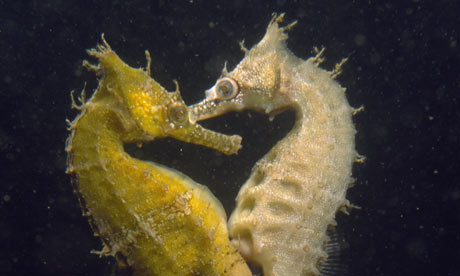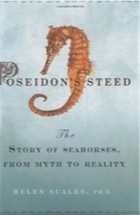The sex life of seahorses
The mating habits of these bizarrely beautiful creatures are fascinating – they are the only species in which males truly become pregnant. We reveal the secrets of the sea bed, plus how to keep seahorses as pets- The Guardian, Monday 2 November 2009
- Article history

Seahorses mating in a heart-shaped embrace. Photograph: George Grall/Getty Images/National Geographic
Peer at a seahorse, briefly hold one up to the light, and you will see a most unlikely creature; something you would hardly believe was real were it not lying there in the palm of your hand. Should we presume these odd-looking creatures were designed by a mischievous god who had some time on her hands? Rummaging through a box labelled "spare parts", she finds a horse's head and, feeling a desire for experimentation, places it on top of the pouched torso of a kangaroo.
- Poseidon's Steed
- by Helen Scales
- 272pp,
- GOTHAM BOOKS,
- £15.99

This playful god adds a pair of swivelling chameleon eyes and the prehensile tail of a tree-dwelling monkey for embellishment – then stands back to admire her work. Not bad, but how about a suit of magical colour-changing armour, and a crown shaped as intricately and uniquely as a human fingerprint? Shrink it all down to the size of a chess piece and the new creature is complete.
No matter how tempting such a strange tale of creation may be, seahorses are real creatures, a product of natural selection and an endangered species. They inhabit a wide stretch of the oceans and are not, as we might suppose, restricted to warm azure waters that lap on equatorial shores. If you stand with your toes dabbling in shallow sea almost anywhere in the world there is a chance you might see a seahorse. Not a very great chance, admittedly, but a chance nonetheless.
Right now, somewhere in the world, sunbeams pierce through shallow water and cast pools of brightness on the seagrass meadow below. The night shift has ended, and diurnal creatures begin to emerge from sleeping hideaways: rabbitfish, parrotfish, damselfish.
Suddenly, two tiny silhouettes come together like a pair of knights on a chessboard. The seahorses greet each other with a nose-to-nose caress and, wrapping their tails around a single blade of grass, they begin a seductive dance, spiralling round and round each other. Blushes of orange and pink give away their emotions and, for a moment, the seahorses swim together, heads tucked down, tails entwined. A gentle humming and clicking from the male is the soundtrack to their flirting.
The first time a seahorse couple meet, this gentle courtship carries on for hours, days even, and it is a risky time. Driven by hormones that interfere with the instinct to hide, they abandon the camouflaged safety of their seagrass home. The female initiates sex by reaching up toward the surface, stretching her body as straight as it will go. This proves quite irresistible to the male, who immediately responds by pumping his tail vigorously up and down.
The couple halt in the open water column and hold their bodies close, forming a heart shape with their touching snouts and bellies. Their first attempt isn't quite right, so they break apart and try again several times until their position is perfected, the female just above the male. Then an extraordinary thing happens. A short hollow tube emerges from the female, which she pushes into an opening in her partner's belly. The couple raise their heads and arch their backs as the female shoots an egg-laden liquid into the male.
Copulation is perfunctory, taking just six or seven seconds. When the male is full with the precious cargo, he wanders off, his bright mating costume already fading. He sways and wiggles his body, settling the eggs into position where they will remain for the next few weeks, growing in a protected internal pond.
The strangest thing about seahorses is that their males are the only ones in the world who experience – firsthand – the agonies of childbirth. Admittedly, there are many fathers who do a great job of helping out with the youngsters. In eastern Australia's rainforests, tadpoles of the marsupial frog wriggle into special pouches slung on their fathers' hind legs. Six weeks later, out hop the next generation of miniature frogs.
Cap comentari:
Publica un comentari a l'entrada